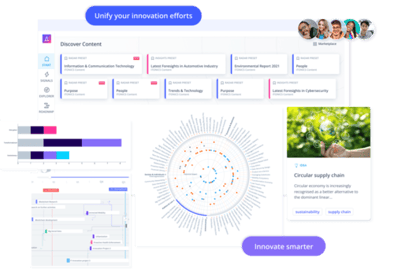Patenting is seen to be the gold standard for protecting a company’s intellectual property (IP) and technologies. In reality, the overwhelming majority of patents hold little value, with approximately 97% failing to cover the expenses incurred during their filing process. The effect of patents for companies is foremost commercial, i.e., to attract investments by showcasing them to investors, trading and licensing them or suing copycats. It is more like a business case than an effective protection strategy which is why other IP strategies, such as trade secrets or informal protection strategies, are more effective in protecting.
Thus, it is a question of whether resell or technology protection is superior to amortizing investments. In this article, we explore the criteria favoring patenting or trade secrets, complexity, tacit knowledge, and a lead time advantage as informal protection strategies to protect your technology’s intellectual property.
Why protect your technology's intellectual property
Technologies are the materialization of a firm’s unique know-how. They enable the creation of products and, by that, what companies need to succeed in the market. If these technologies are proprietary and unique, there is a likely chance to generate a sustainable competitive advantage. That is why, effective protection of a company’s intellectual property (IP) is a must to secure a company’s market position and revenue stream. The IP strategies to protect can be formalized, such as patents and trade secrets, or informal, including high complexity, tacit knowledge, strong branding, and a lead time advantage. Even more, they are not only protection strategies but also rewarding strategies to commercialize technologies.
Yet, none of the IP protection strategies is a silver bullet, although patenting seems to be the obvious choice. The effectiveness of each IP protection strategy depends on certain factors and a company’s overall IP strategy. Approximately 97% of patents filed never cover the expenses incurred during their filing process. The value distribution across a company’s patent portfolio is highly skewed, with a small number of valuable, high-impact patents and large numbers of patents of marginal importance. Is it thus worth spending as much as the common 1% of the R&D budget solely on filing patents (excluding the costs of enforcing those patents)?
In a nutshell: The key insights
| IP Protection Strategies | Meaning | Consequence | When? | Risks |
Formalized, disclosed
|
Legal rights to restrict | Financial compensation, e.g., Investor Evaluation, Licensing, Trading, Penalty Payment | High tech investment costs with a high risk of losing to competition
|
|
Formalized, secret
|
Legal rights to restrict | Financial compensation if breached | Partnerships
|
|
Informal, secret
|
Strategic Means to Preclude | Less easy to understand
|
Technology with high impact and complexity
|
|
The commercial re-sell protection strategy: patents
Why firms patent
Firms pursue patents primarily to safeguard new, non-obvious, and useful inventions that diffuse in different applications. If a patent submission fulfills the necessary requirements, the patent holder receives the legal protection and exclusive right to make use of an invention for a limited area and time by stopping others from making, using, or selling it without authorization. This legal protection serves as a potent deterrent against competitors and provides a solid foundation for attracting investments and negotiating lucrative licensing agreements. If someone violates this exclusive right, they can be reported and fined. In essence, patents grant a monopoly of usage and, as a consequence, commercially attractive revenue paths.
How firms patent
To file a patent, the inventor or a patent attorney drafts a patent application describing the invention in detail, including its features, functions, and potential applications. This document must meet the specific requirements of the patent office where the application will be filed. A patent is a national right, and different offices have different requirements. In the EU, patents protect technical inventions that are industrially applicable (USA: useful), novel to the world, and non-obvious to the average professional practitioner. A patent application remains secret (i.e. unpublished) within the first 18 months after applying; however, it can take 30-64 months until a patent gets granted and can cost ca. €50.000 only in fees (not including the costs for legal advisory services).
After filing, the patent application undergoes examination by a patent examiner at the patent office. The examiner assesses the application to ensure compliance with patent laws and determines whether the invention meets the criteria for patentability, including novelty, non-obviousness, and utility. The examiner may issue one or more office actions, which are official communications detailing any objections, rejections, or requirements for the patent application. The inventor or their attorney must respond to these office actions within a specified time frame, usually within six months, by addressing the examiner's concerns and amending the application as necessary. This may involve multiple rounds of communication and negotiation with the examiner.
If the patent examiner determines that the invention meets all patentability requirements, the patent application will be allowed, and a patent will be granted. However, if the examiner maintains objections or rejections that cannot be overcome, the application may be rejected. In this case, the details of the invention will still be disclosed, yet, patent rights themselves are not granted, and the applicant does not receive the exclusive rights to restrict usage. Once a patent is granted, the inventor must pay maintenance fees periodically to keep the patent in force. In many countries, patents have a limited term, usually 20 years from the filing date, after which they expire.
When firms patent
The first critical factor for firms to patent is having the financial and legal resources not only to file a patent but also to find and sue infringers. Patent holders need to enforce their right of exclusivity in litigations and prove that someone else has infringed the patent to seek remedies such as damages or injunctions. While companies gain the benefit of preventing competitors from copying development results and improving their market position, the patent-holding company needs to be in a position to claim its rights. Without the financial and legal means to identify infringements and sue infringers, patents become of no value.
A second critical factor for firms to patent is the expected diffusion of the technology and its ability to determine technological standards. If it is likely that the technology is a key technology for many applications, patenting prevents other competitors from bringing very similar technology to market. By holding a patent, the patent-holding company can set an industry standard and collect royalty payments or license fees. That is why, many suppliers in the Automotive industry, such as Bosch, Continental, or Denso, are leading patent rankings.
Besides these first two major factors, there are two more minor factors. A third factor for firms to patent is the ease of replicating it. Although one technology might be novel and non-obvious, there is a likely chance that other companies find it on their own if the technology can be easily created once the mechanics are understood. That is why a patent helps to create a time advantage if the complexity of the technology is not super high. Fourth, there are organizations in which patents are like a currency. For distinguished engineers and R&D-heavy firms, engineers’ reputation is based on the number of patents. This holds also true for smaller firms, trying to convince investors. Investors thus factor in the innovativeness and market potential into their evaluations by the patents applied/held.
The commercial technology-edge strategy: trade secrets, complexity, tacit knowledge, and first-to-market
Why firms keep technology intellectual property secret
As every patent registration includes the disclosure of the unique knowledge in a patent filed, there is still a likely risk that the right to exclude, i.e., the patent, is not granted, expenses will never be covered, or - even worse - that infringers are not identified and sued. That is why, companies also choose IP strategies that do not disclose unique knowledge. Similar to patents, trade secrets grant the right to prevent others from using or disclosing secrets without authorization. It is a formal agreement, like a non-disclosure agreement, that commits the holders to not breach confidentiality (or otherwise fear legal consequences) and does not require formal registration and public disclosure.
In addition to formal contracts with employees or partners involved in co-innovation, there are informal arrangements that complicate the understanding of a technology’s mechanics and the protection of a firm's technology intellectual property (IP). Complexity, tacit knowledge, and being the first to market are often the more effective protection strategies. Specifically, complexity and tacit knowledge hinge on the restricted accessibility of the required knowledge. While patents reveal this knowledge, complexity, and tacit knowledge compel potential imitators to independently acquire the necessary knowledge. In addition or as a sole IP protection strategy, being fast-to-market is also effective as it helps to create a recognition of a certain brand with the respective technology. This first-mover advantage will complicate building the same position - maybe, even with better technology - for competitors. What is once remembered, is hard to cross out again.
How firms keep technology intellectual property secret
Trade secrets are formal internal agreements between different parties to ensure that the involved parties do not share confidential information beyond what is agreed. Trade secrets do not require a formal registration. Usually, trade secrets manifest in non-disclosure agreements which are signed by the parties involved. If breached, the injured party can assert claims for damages. However, similar to patents, this requires the identification of the leaking party and the value of the damage. It is so far effective as it restricts the easy sharing of knowledge. However, once brought to market, competitors still have the option to observe, test, and disassemble the products where the technology is used. Here, trade secrets do not provide any specific protection.
Firms commercializing their technologies and not holding patents need to apply and complement their technology IP protection with other informal strategies. The most effective protection strategy is the complexity of the technology. At best, the mechanisms of the technology are non-obvious and consist of multiple, intertwined parts, or costly production processes. All these components build a barrier and require high sunk costs to copy the technology. Indeed, the majority of technologies might not meet these characteristics which is why this technology protection strategy might be only valid for some groundbreaking inventions.
In other cases, firms only have the option to leverage their brand strength and be fast-to-market. Although not perfectly designed, bringing inventions fast to market coupled with a unique image can outcompete competitors, let other inventions shine as copycats, or create high switching costs. If adopters are already used to a technology that meets their needs, they will not easily switch to another - maybe even better - technology. This first-to-market IP protection strategy requires a strong and compelling marketing strategy.
When firms keep technology intellectual property secret
The first critical factor for firms to not disclose their technology IP is a cost consideration. If firms do not possess the legal and financial resources to patent and claim patent rights or it is unlikely to license the usage of technology, it is more effective to hold the technology's intellectual property secret. If the usage is not likely to diffuse in many applications, it is likely that it is not attractive enough for copycats to invest in researching and building the technology.
A second critical factor is the uniqueness of the technology and its expected diffusion rate. If it is likely that a large majority of adopters will benefit from the technology immediately and it is easy to understand, the advantage gained from being fast, and a strong branding outweighs the monopoly position gained from patenting. Although debatable what and whether patentable, OpenAI (and ChatGPT) is an example of a strategy to keep IP secret and be fast to market as competition cannot easily mimic their technology, and adopters now associate the technology with this brand.
A third critical factor for firms to not disclose their technology IP is the complexity of the technology coupled with its sunk costs. If it requires considerable investment to build the technology, firms are in a better position to keep their IP secret as the time competitors need to catch up can already be invested in improving the technology. Any disclosure of relevant knowledge crowds out the time advantage.
A decision tree to help you choose your technology intellectual property protection strategy
Based on the analysis of patenting, trade secrets, and the informal intellectual property protection strategies, a decision tree emerges that helps Chief Technology Officers, and Patent and Innovation Managers to identify the right strategy given different factors. It is to say that trade secrets are common business practices and are applied independently of the go-to-market protection strategy. Trade secrets are formal internal agreements that bind the respective employees to the viability of their company or co-innovating partners to the success of the project. Yet, when it comes to the marketing of technology, each decision needs to include the legal position, financial situation, reputation effects, brand strength, technology characteristics, and revenue strategy.
To secure the long-term amortization of any technology investment, it is essential to couple each technology with the right intellectual property protection strategy. Within ITONICS, you gain the advantage of keeping an easy overview of your IP portfolio. This is so far a game changer as nearly 97 % of the patents are not further leveraged. Yet, with an easy overview of all patents filed, there is an unlocked additional revenue stream by activating these unused patents and selling them or actively using your patent portfolio to identify infringers.
What's next: Map technologies and patents to unlock new revenue potential
Stay on top of your IP and technology protection strategy. Reduce the hassle of activating your IP portfolio and unlock an untapped revenue stream. Map your patents, categorize them, and get an easy overview of your strengths and weaknesses in protecting your technology IP using the ITONICS Innovation OS. Curious about pricing or plans? Our corporate technology experts are ready to assist you in a personal demo session.

See the ITONICS Innovation OS in action











